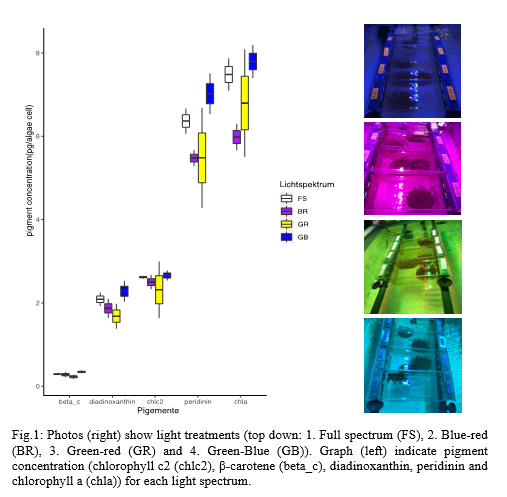JELLYFISH AQUACULTURE FOR HUMAN NUTRITION – PROSPECTING AND MANIPULATING LIGHT ACCESSORY PIGMENTS IN THE ENDOSYMBIOTIC JELLYFISH Cassiopea andromeda
Introduction
Marine resources provide an affluence of bioactive substances that could possibly serve as novel food additives and nutraceuticals to enhance human diet and animal feed. With regards to sustainable resource exploitation , it is particularly useful to uncover the nutritious potential of highly abundant yet underutilized biomass, such as j ellyfish. The endosymbiotic mangrove jellyfish Cassiopea andromeda might be an exceptionally promising species in this context . Next to fast growth rates, wide global distribution and robustness towards environmental change ( e.g. Mammone et al., 2021) , C. andromeda is a semi-sessile benthic species, which makes it very well suited for captivity culture (Pierce, 2005) . Moreover, recent studies have revealed the presence of nutritionally valuable algae composites such as carotenoids, in other endosymbiotic jellyfish (Leone et al., 2015) . As functional pigments carotenoids have strong nutraceutical properties, they can act antioxidative, anti-cancerous, anti-obese, anti-inflammatory, and cardioprotective (e.g. Van Chuyen and Eun, 2017) . Hence, in this study, we investigated the pigments contained in C. andromeda and its endosymbiotic algae. In addition to the characterization and quantitative estimation of pigments , the potential of light spectra changes for the manipulation of the pigment composition and amount was tested.
Materials and Methods
Over a period of four weeks, C. andromeda specimens were exposed to four different light spectra ( 1. full-spectrum , 2. green-blue , 3. green-red and 4. blue-red) at a constant light intensity (250 µmol/m2/s). Over the experimental time, growth (weight and diameter) and activity (umbrella pulsation) of the jellyfish was monitored. Moreover, the p hotosynthetic efficiency of the endosymbiotic zooxanthellae was determined by measuring the maximum quantum yield of photosystem II (photosynthetic efficiency; Fv/Fm), using a portable pulse amplitude modulation (PAM) chlorophyll fluorometer. Pigment analyses were performed using reversed-phase high-performance liquid chromatography (HPLC).
Results
Four light accessory pigments (chlorophyll c2, β-carotene, diadinoxanthin and peridinin) were found next to chlorophyll a, in the endosymbiotic jellyfish C. andromeda . With a peak concentration of 480 µg/g dry weight, peridinin was the most prevalent carotenoid, followed by diadinoxanthin and β-carotene. The concentration of all pigments was generally highest, although not significantly, when the jellyfish were exposed to green-blue light. The four different light spectra did not significantly affect jellyfish growth and photosynthetic efficiency. However, jellyfish treated with green-red light conditions exhibited significantly lower umbrella pulsation rates.
Discussion and Conclusion
This study revealed that next to chlorophyll, three carotenoids, namely peridinin, diadinoxanthin and β-carotene, are the dominant light accessory pigments in the endosymbiotic jellyfish C. andromeda. Next to the well-known provitamin A activity of β-carotene , previous studies have identified strong anti-cancer properties of peridinin (Yoshida et al., 2017). To our knowledge, the dietary potential of dia dinoxanthin has not been studied yet, however, many reports demonstrated that marine carotenoids have higher bioactivities than those from plant sources or synthetic compounds (reviewed by Van Chuyen and Eun, 2017). Hence, the carotenoid profile exhibited by C. andromeda can be considered of high nutritional and nutraceutical value. Although not significant, the changes of carotenoid concentrations at the different light spectra indicate promising perspectives , to enhance the production of target compounds , such as carotenoids, through the manipulat ion of key parameters in captivity culture. Given that the uptake of carotenoids is indispensable for animals and humans , the exploration of natural carotenoid sources is highly relevant to enhance its accessibility for human consumption and animal feed . This study provides first insights into prospecting and manipulating the C. andromeda holobiont for marine carotenoids. We propose to further investigate the nutritional value (e.g. antioxidants, fatty- and amino acids) of C. andromeda and explore its potential to counteract malnutrition , especially in countries of the global south .
References
Leone A et al. (2015) The Bright Side of Gelatinous Blooms: Nutraceutical Value and Antioxidant Properties of Three Mediterranean Jellyfish (Scyphozoa). Mar. Drugs 13: 4654-4681.
Mammone M et al. (2021) High photosynthetic plasticity may reinforce invasiveness of upside-down zooxanthellate jellyfish in Mediterranean coastal waters. PLoS ONE 16(3): e0248814.
Pierce J (2005) A system for mass culture of Upside-down jellyfish Cassiopea spp as a potential food item for medusivores in captivity. Int. Zoo Yb. 39: 62–69.
Van Chuyen H, Eun J B (2017) Marine carotenoids: Bioactivities and potential benefits to human health. Critical Rev. in Food Sci. and Nutrition Vol. 57, No. 12: 2600-2610.
Yoshida T et al. (2007) Halocynthiaxanthin and peridinin sensitize colon cancer cell lines to tumor necrosis factor-related apoptosis-induci.ng ligand. Mol. Cancer Res. 5: 615-625.
